Historic welcome pole, rooted in Klahoose origin story, brings healing to the people
Ernest Puglas brought family’s carving legacy to ‘Cortes Island’ to craft the pole, which was raised in ceremony on Wednesday.

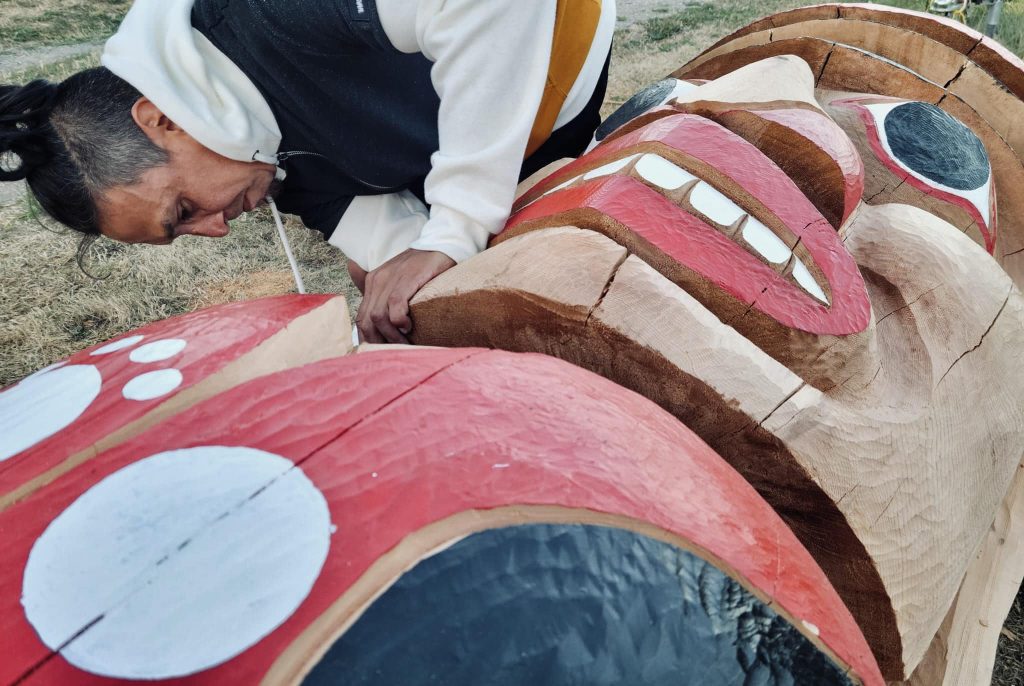
When Ernest Puglas was 12 years old — while his family was working away canning salmon — he went off on his own into his grandfather’s carving shed.
His grandfather is Kwakwaka’wakw master carver Sam Henderson Sr., a ‘Nakwaxda’xw chief from Ba’as village (Blunden Harbour).
“I was in the shed when they were all canning, and I touched my uncle Billy’s knife,” he recounts. “And I carved my first plaque with his knife.”
Now, almost three decades later, Puglas is again using a family knife, this time to carve a welcome pole in Klahoose homelands — a historic event as the first one carved in the village at Toq (Squirrel Cove) since European contact.
“This is 100 years old,” he says, picking up his knife with a curling tip and a wooden handle that’s smooth with use. “It belonged to my grandfather, this knife here. And I carved most of this totem with this one knife.”
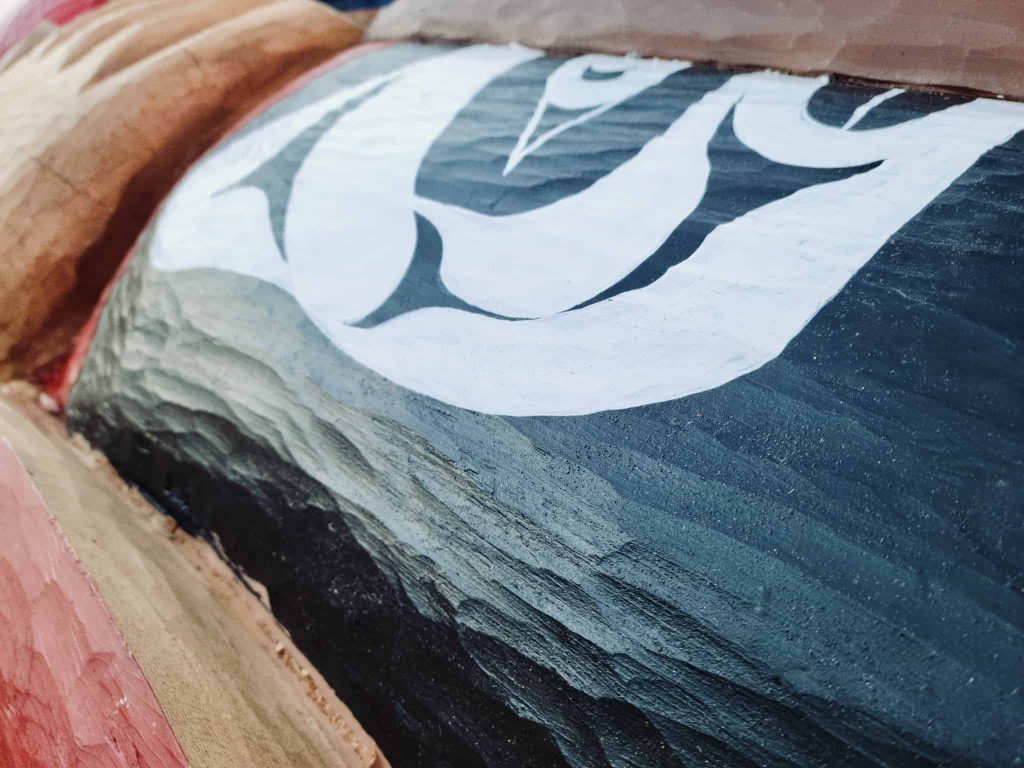
Klahoose First Nation is a small community with less than 100 members living on reserve. The imposed reserve on “Cortes Island” is at one of the many sites they’ve occupied across their large territory.
During an evening in the early fall, Puglas is working at “Squirrel Cove,” and the day’s last golden light reflects on the waves in the ocean beside him.
The same light catches the rippled texture of the traditional knife finish on the welcome pole, lying mid-carve on the grass.
It took Puglas 26 days to finish the carving, which he nicknames the Toq Princess. Toq is the ʔayʔaǰuθəm name for “Squirrel Cove,” and his carving tells the story of a woman who lived at “Toba Inlet.”
He asks if the figure has a womanly energy, and it does. Wearing a cedar hat with three red bands painted on it, she has distinct eyebrow shapes and wears a blanket with an apron.
“She was the keeper of 11 dogs,” shares Puglas. “She was a clam digger and she was the daughter of a chief.”
Ten of the pups are male, seen in 10 white paw prints painted on the rim of the blanket. The eleventh pup is female, seen on the front of her apron of her blanket, along with a clam digging fork.
The woman depicted in the carving is the central figure in the toq qaymɩxʷ (Klahoose) origin story, explains Michelle Robinson, social development manager for the First Nation. The story goes that the woman is tricked by a declined suitor into eating pitch that turns into a pregnancy.
Raven decides she is a disgrace, and asks her to run an errand. While she’s off, the entire village leaves her to be alone — without tools, or fire. But her grandmother hides an ember in a clam shell.
The grandmother whispers the secret of where it is buried to a small dog, to tell her granddaughter when she returns. Between having fire, and being able to dig clams, she survives.
The granddaughter gives birth to a litter of what seems to be puppies — but they are her children, disguised in furs. She eventually discovers them in human form by following the sound of drums at night. She sees them with their furs off, dancing by the fire.
She knows she can keep them in human form by throwing the furs into the fire. Through digging clams, she is able to feed her children until they have grown enough to help her.
Each one takes a role: fisher, hunter, cedar gathering, and the one daughter is who works with each item, crafting into meals, tools, weaving. After Crow decides to check in on her, Raven returns with everyone.
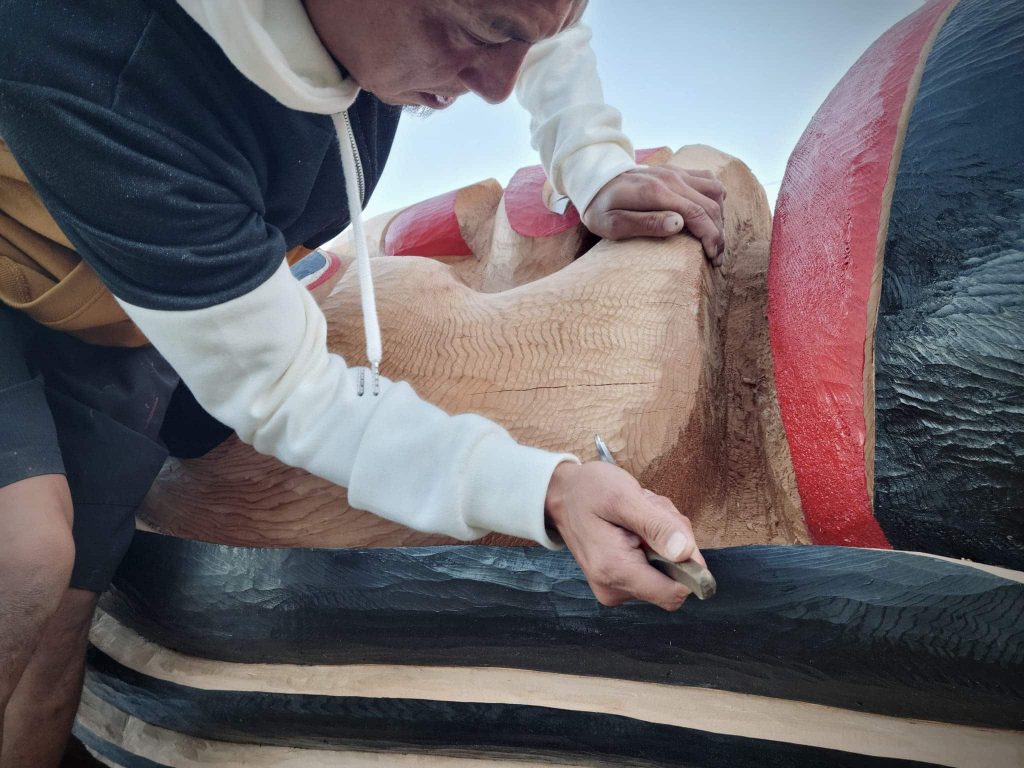
A provincial grant funded the carving. The nation chose the theme for Puglas to work with, and asked him to incorporate their healing stone into the design. The stone itself also carries the story of Klahoose’s belonging to this place.
“When the churches were coming to burn all our relics, and take our ceremonial things, we weren’t allowed to practice culture, including use of anything with animals or symbols,” Robinson explains. “They took it away.”
Robinson says that the stone, about 30 by 35 cm in diameter and 12 cm thick, has been carved to depict Raven. The stone is special to the nation and was hidden at Toq in the mid- to late- 1880s, during the time of Chief Joseph Hill, so that it couldn’t be taken away by church or government officials.
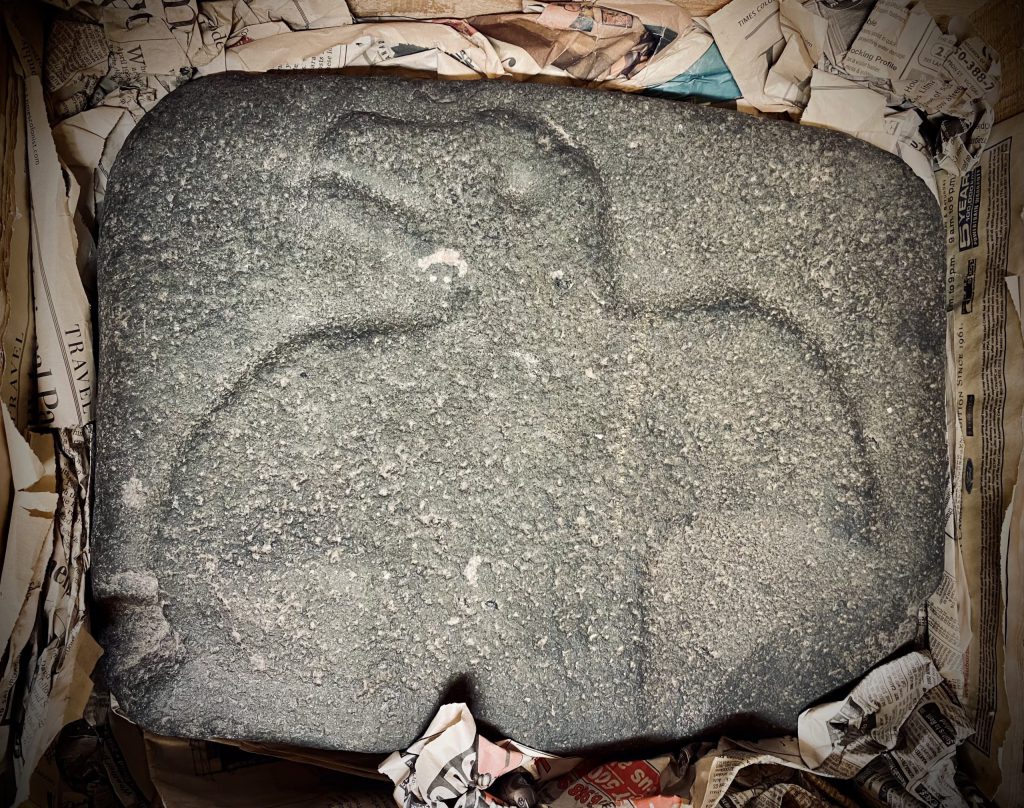
“They sent this stone out to be protected, they hid it here. And so we know it was of great importance,” Robinson says.
The stone remained hidden for a long time, she says, but eventually was taken by an electrician who asked for it as payment for his services on the reserve, Robinson says. When he passed away, he left it in his family’s care, directing them to return it to Klahoose.
“So that came back to us, and is now going to be worked into the base of the welcome pole, our creation story,” Robinson says.
“This welcome pole is going to speak to people — where they’re from, and who they are, a sense of identity.”
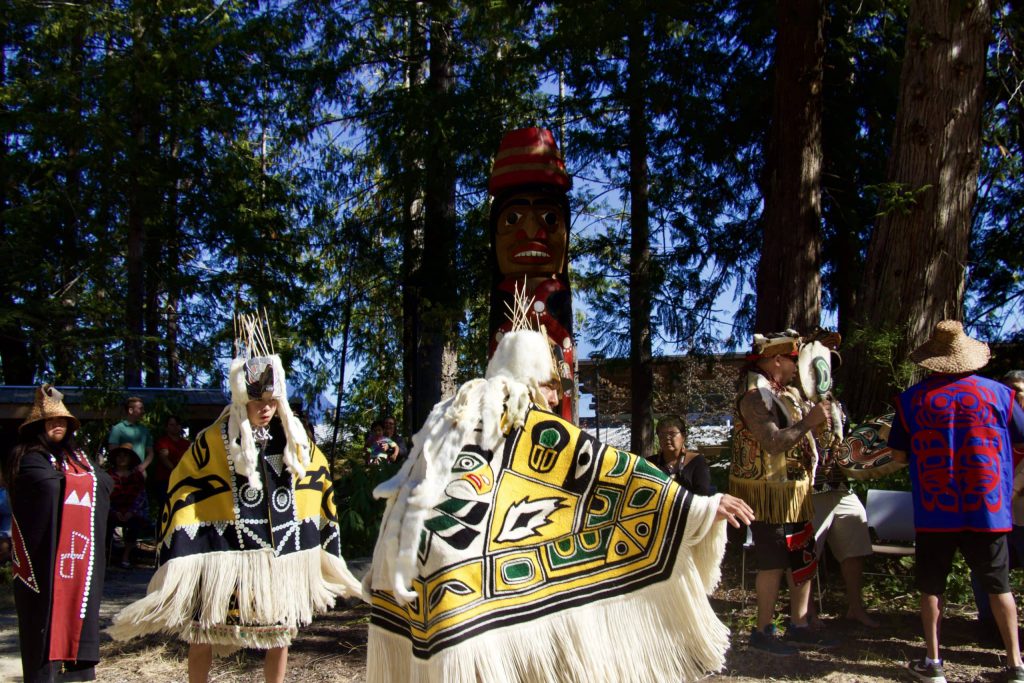
Part of the pole’s process was to invite the community to share in the pride. When Puglas cleaned the bark off the log, before he began to mark out and carve, the community gathered around — Elders, children, community members, and staff — and each one brushed the log with cedar in turn.
“You already felt the spirit of the log, but you could feel it all come alive,” says Robinson.
Klahoose Chief Steven Brown says the pole is already having a positive effect in the community. Earlier in September, he was feeling rattled after just having dealt with racist commentary from protestors who were against Klahoose’s logging activities. He was driving home and saw the pole close to completion.
“Then I see Ernie and Steph and this beautiful pole,” he recalls, “It put everything in perspective and washed away all those negative feelings.”
He hopes his community has that same experience with the pole — that it brings positivity, optimism and a feeling of home.
“We talk all the time about nation rebuilding and cultural revitalization,” he says. “And this is a perfect example of what that looks like in a tangible form. And that’s really powerful for our community.”
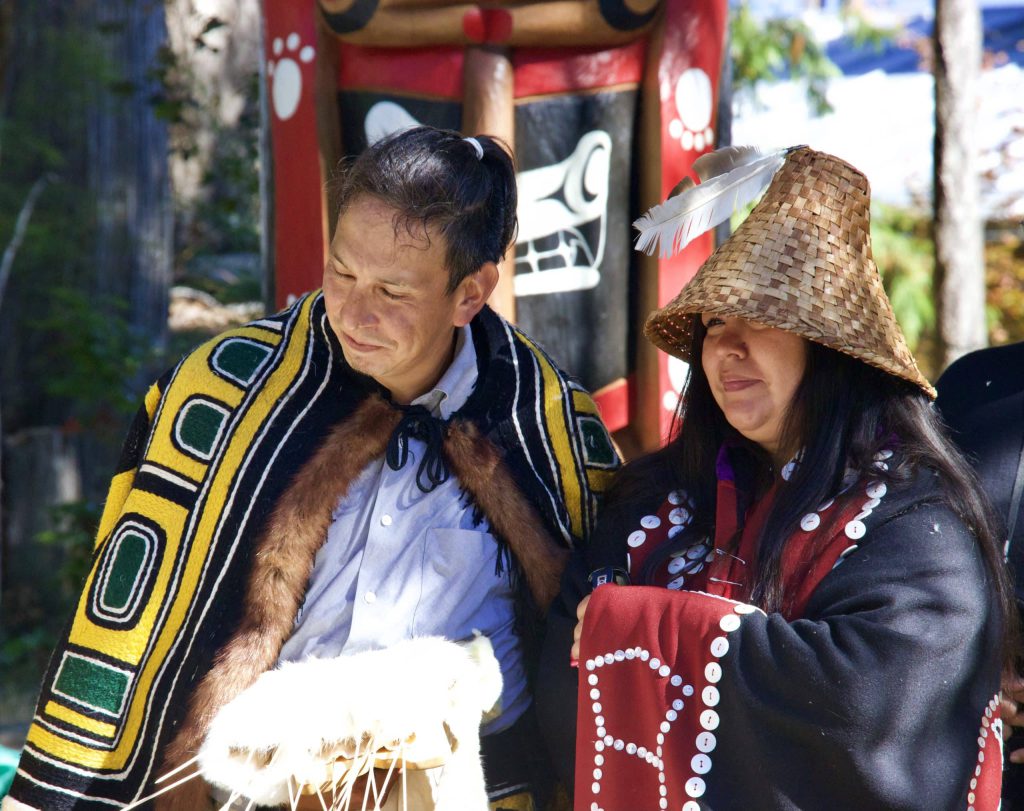
For the past three years Puglas has been living at Klahoose, the home of his partner Stephanie Hanson. He grew up watching many esteemed carvers from all around him, while growing up in his own Kwakwaka’wakw territories.
“I’m the youngest grandchild of 100 grandkids. So to be able to carve is a blessing for me,” he says.
“I carved under the wings of a lot of my cousins. Totem-pole wise, I learned everything I know from Tommy Hunt Jr.”
Puglas really watched him and was given the opportunity to be a part of a couple of Hunt’s major projects. “I really couldn’t do any of this, if I didn’t pay attention to his block up form.”
Junior Henderson was also one of his teachers, as was Greg Henderson.
“I paid attention to the art form that they created. So I’d be able to do it myself.” He brushes a cedar curl off the carving gently, and says, “And this is what’s come of it.”
When he came to “Squirrel Cove” to be with Hanson, he describes it as a time when he was lost. About four months ago, he was able to come out of this dark time in his life and return to his craft that’s been with him since childhood.
Crafting the welcome pole, he says, has helped in his healing and recovery.
“I was stuck in drugs and alcohol, and I was away from my artwork for a good five years,” he says.
“To be able to carve this for their community, and clean my life up at the same time is phenomenal … So this is the first pole of many, I hope.”
He picks up a brush and small pot of red paint, and begins to touch up spots on the carving. He pauses to chuckle, “This colour red? It’s called ‘No more drama.’”
Hanson helped him with the layout of the pole — calculating the chalk lines to turn a rough log into a piece ready for carving.
It was a skill waiting to be used, and her hands have worked on this piece, too. She smiles as she strokes the left side of the depiction of the blanket.
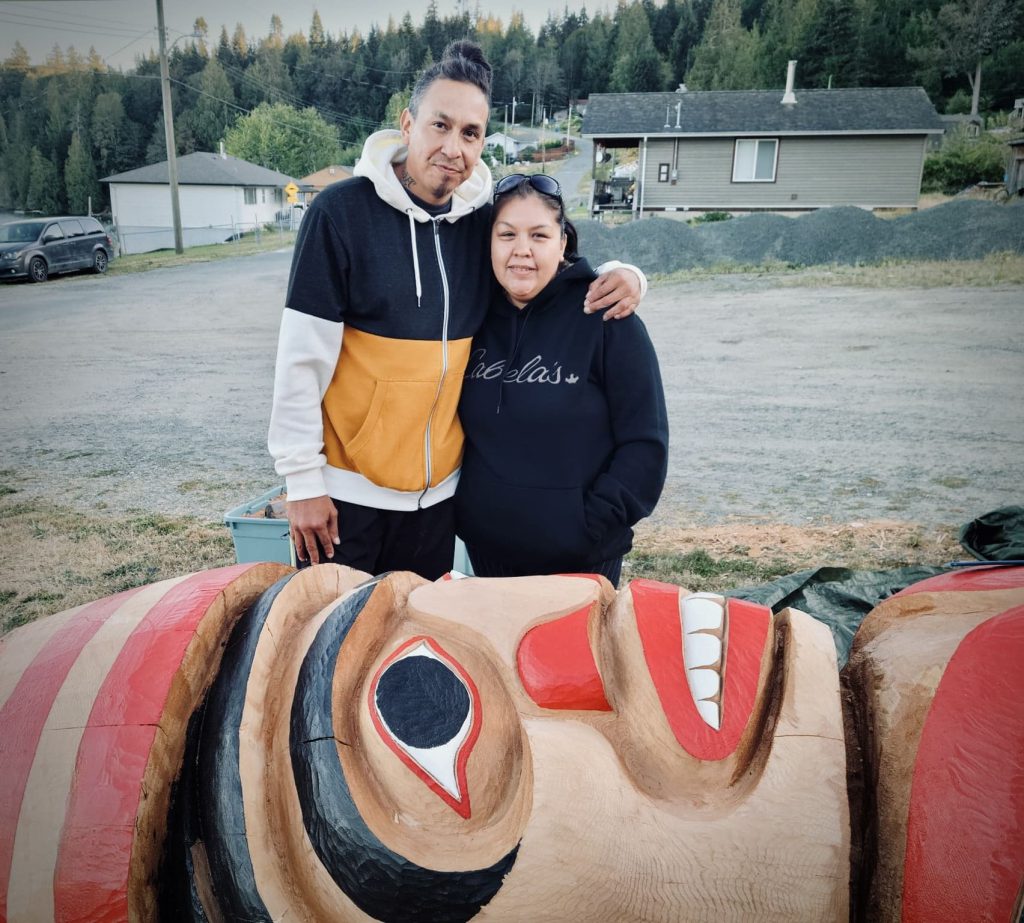
“I did that whole left side of the blanket, and then he went over it,” she smiles.
The carving was raised in ceremony on Wednesday, at the entrance to the multi-purpose building at Klahoose. Amid prayers, blessings and dancing, fluffy eagle down drifted over the celebration.
“This is your medicine to the world,” Robinson thanked Puglas and Hanson. “This is our mother, she welcomes you, she’s healing. I’ve felt the ancestors here throughout the carving.”
Author
Latest Stories
-
‘Bring her home’: How Buffalo Woman was identified as Ashlee Shingoose
The Anishininew mother as been missing since 2022 — now, her family is one step closer to bringing her home as the Province of Manitoba vows to search for her
-
Book remembers ‘fighting spirit’ of Gino Odjick, hockey’s ‘Algonquin Assassin’
Biography of late Kitigan Zibi Anishinabeg left winger explores Odjick’s legacy as enforcer in the rink — and Youth role model off the ice
-
St. Augustine’s survivor hopes for closure after evidence of 81 unmarked graves released
50 years after the residential ‘school’ closed, shíshálh Nation announces evidence of many burial sites. A Tla’amin Elder wonders how many more children died













